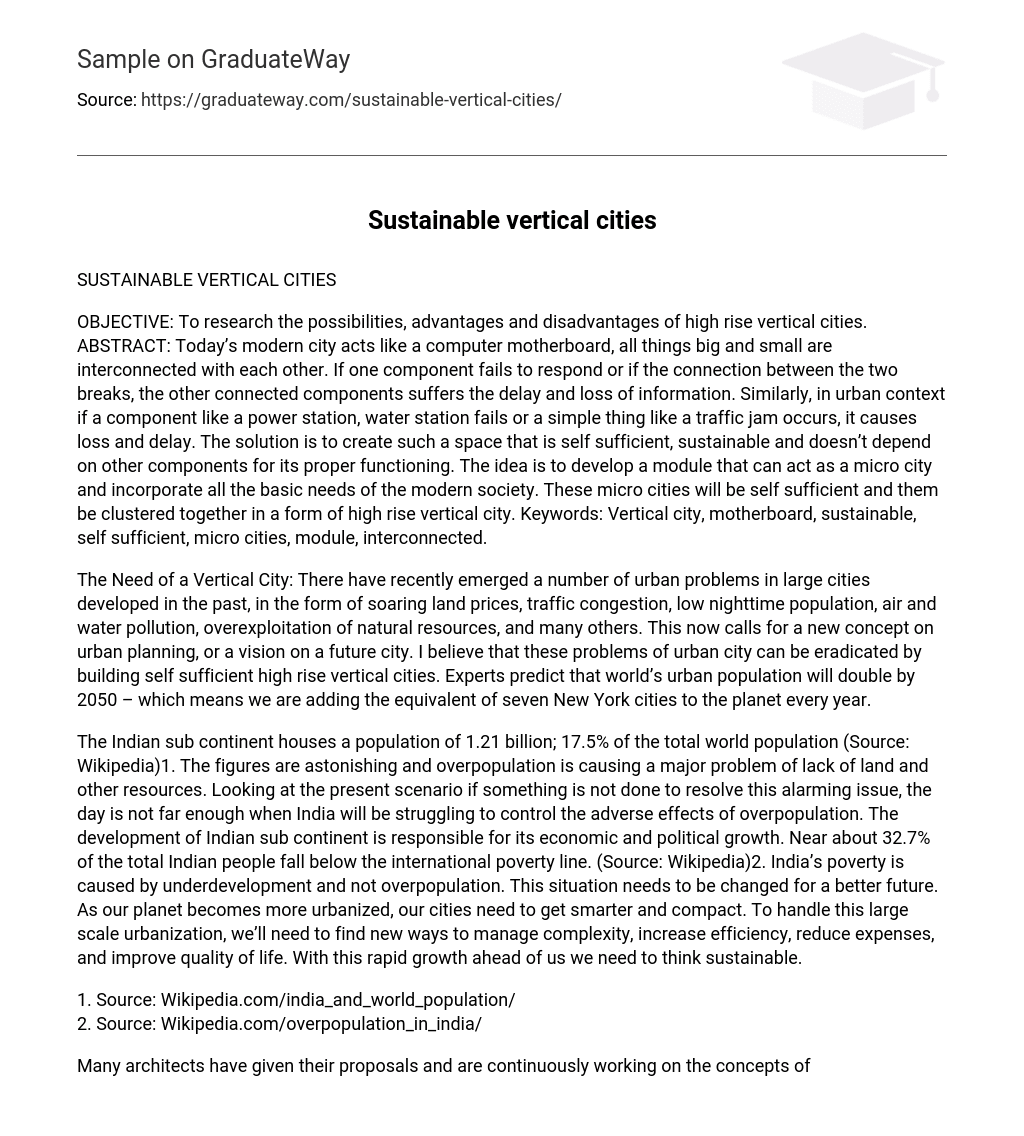To research the possibilities, advantages and disadvantages of high rise vertical cities. Today’s modern city acts like a computer motherboard, all things big and small are interconnected with each other. If one component fails to respond or if the connection between the two breaks, the other connected components suffers the delay and loss of information. Similarly, in urban context if a component like a power station, water station fails or a simple thing like a traffic jam occurs, it causes loss and delay.
The solution is to create such a space that is self sufficient, sustainable and doesn’t depend on other components for its proper functioning. The idea is to develop a module that can act as a micro city and incorporate all the basic needs of the modern society. These micro cities will be self sufficient and them be clustered together in a form of high rise vertical city. Keywords: Vertical city, motherboard, sustainable, self sufficient, micro cities, module, interconnected.
The Need of a Vertical City: There have recently emerged a number of urban problems in large cities developed in the past, in the form of soaring land prices, traffic congestion, low nighttime population, air and water pollution, overexploitation of natural resources, and many others. This now calls for a new concept on urban planning, or a vision on a future city. I believe that these problems of urban city can be eradicated by building self sufficient high rise vertical cities. Experts predict that world’s urban population will double by 2050 – which means we are adding the equivalent of seven New York cities to the planet every year.
The Indian sub continent houses a population of 1.21 billion; 17.5% of the total world population (Source: Wikipedia)1. The figures are astonishing and overpopulation is causing a major problem of lack of land and other resources. Looking at the present scenario if something is not done to resolve this alarming issue, the day is not far enough when India will be struggling to control the adverse effects of overpopulation. The development of Indian sub continent is responsible for its economic and political growth. Near about 32.7% of the total Indian people fall below the international poverty line.
India’s poverty is caused by underdevelopment and not overpopulation. This situation needs to be changed for a better future. As our planet becomes more urbanized, our cities need to get smarter and compact. To handle this large scale urbanization, we’ll need to find new ways to manage complexity, increase efficiency, reduce expenses, and improve quality of life. With this rapid growth ahead of us we need to think sustainable.
Many architects have given their proposals and are continuously working on the concepts of vertical cities. The Takenaka research institute, Japan, have already designed a vertical city called ‘The Sky City’ which is proposed to be built in Tokyo city. Many buildings working on the same principals have already been built for example ‘The Shard Tower’ by Renzo Piano which is built in London. The building incorporates residences, offices, restaurants and spas. Another example is the mighty ‘Burj Khalifa’ in Dubai. The building too incorporates private apartments, offices, commercial hubs, restaurants and helipads.
A number of urban and environmental problems have recently emerged in the past development of large cities, including traffic congestion and soaring land prices due to centralization, pollution of land, air, water and waste disposal issues. The cities are becoming inhabitable gradually and nothing Is been planned to improve the situation. To resolve the alarming problem we need to change the way we live, change the way our city works and improvise new ways to overcome the problem. The concept of vertical smart city is the solution for the problem. If you spread the whole human population on earth in a rural type density; let’s say each family in a house with a garden around, you destroy quickly the whole ecosystem of the planet.
If you concentrate the populations in high-density urban conglomerates, the rest of the planet stays free for the other ecosystems to develop. Besides this, sanitation, transportation, education and health rates are much higher in megacities, and it costs far less per person to maintain those levels than in rural environments. So, raising density can be a big part of the solutions we’ll need to face environmental problems. There helps the concept of vertical cities.
The idea of vertical city is an innovative solution to many of the problems of today’s urban world. The building will house double, triple or even more amount of population than the conventional skyscraper can handle. It will incorporate multiple facilities, private and public spaces like clubs, spas, restaurants, hotels, apartments, offices parks and more in one single massive building.
The people will travel within the skyscraper through special multilevel elevators and electric pod trams. This will eliminate the daily long hour journeys to offices and other public spaces. People will work more efficiently and would get more time instead of wasting time on commuting to workplace and back home. This would further result in low energy consumption and fuel wastage. The city will be self sufficient and fulfill its requirements of energy through wind mill farms and solar arrays constructed on the skyscraper itself. A single building module can even be used as a vertical farm, poultry farm or a cluster of industries that than exchange information easily and work efficiently.
This is a nice way of checking the wastage, fuel consumption and pollution caused by industries and can be controlled and filtered properly. The large building modules of vertical cities can then be interconnected through sky bridges and metro trains. The cities will exchange information easily and consume less resources and energy and in result save tons of fossil fuels used every year on commuting and in traffic jams. The vertical smart cities are the future of sustainable environment and healthy living. They will change the way we live and see the world around us.





